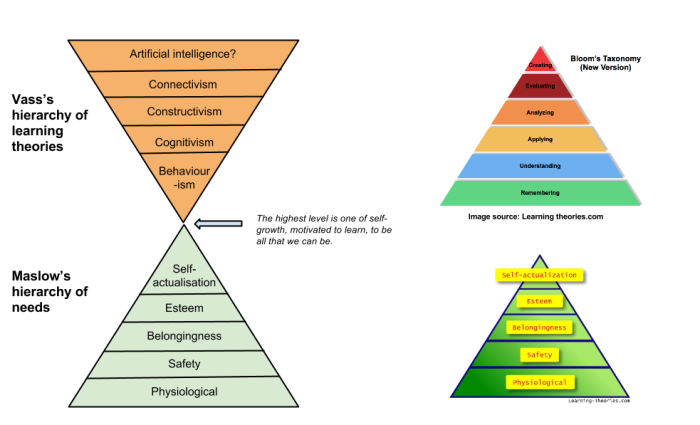Do you subscribe to or have you even heard of emerging learning theories such as connectivism or transactional distance?
How about more of a learning strategy or framework known as TPCK (or TPACK) or SAMR?

The SAMR framework
Dr. Ruben Puentedura developed the SAMR model as a way for teachers to evaluate how they are incorporating technology into their instructional practice. You can use SAMR to reflect upon how you are integrating technology into your classroom.
You can read more about and from Dr. Ruben Puenedura here on his blog: http://www.hippasus.com/rrpweblog/ in particular I’d recommend looking at his latest conference slides from Oct 29, 2014 where he aligns TPACK directly with SAMR. For a number of years now the two frameworks have been operating in parallel with many educators switching between them or struggling to decide which works best in their area. Apple themselves have openly adopted the SAMR through their network of ADEs.
So what is TPACK? Well for starters their are loads of videos and simple explanations, just google it and you’ll probably find http://tpack.org.

The TPACK framework
This site explain it nicely as:
Technological Pedagogical Content Knowledge (TPACK) is a framework that identifies the knowledge teachers need to teach effectively with technology.The TPACK framework extends Shulman’s idea of Pedagogical Content Knowledge.
At the heart of the TPACK framework, is the complex interplay of three primary forms of knowledge: Content (CK), Pedagogy (PK), and Technology (TK). The TPACK approach goes beyond seeing these three knowledge bases in isolation. TPACK also emphasizes the new kinds of knowledge that lie at the intersections between them, representing four more knowledge bases teachers applicable to teaching with technology: Pedagogical Content Knowledge (PCK), Technological Content Knowledge (TCK), Technological Pedagogical Knowledge (TPK), and the intersection of all three circles, Technological Pedagogical Content Knowledge (TPACK).
Effective technology integration for pedagogy around specific subject matter requires developing sensitivity to the dynamic, transactional relationship between these components of knowledge situated in unique contexts. Individual teachers, grade-level, school-specific factors, demographics, culture, and other factors ensure that every situation is unique, and no single combination of content, technology, and pedagogy will apply for every teacher, every course, or every view of teaching.
The framework was developed by Mishra & Koehler back in 2006 as they searched for a way to integrate technology with Lee Shulman’s Pedagogical Content knowledge approach.
I personally have used both in my classrooms over the past decade and continue to find them both useful as separate frameworks. I often find the SAMR model more applicable when looking specifically at a new tool or device. It allows you to ask the question – why am I using this? Or what does it allow me to do that I couldn’t do before? How can it “redefine” the learning task? All great reflective questions we should be asking when we approach the classroom with something we’ve done before. For more great reflection on TPACK check out this blog here: http://silvanameneghini.com/2013/12/09/is-technology-shoving-pedagogy-to-the-center-stage-tpack-reviewed/
So what learning theories do you use in the classroom of today? When technology is ever present, how do you incorporate the best of what you know with new advances or the emerging consequences of these advances (eg. the answer to what you used to ask can be answer by Siri on your phone in 3 seconds!)?
The challenge for educators is not to throw the baby out with bathwater.
IMHO I would argue there is a place for all accepted learning theories in our classrooms. I for one would be the first to admit I’ve had students who have not responded well to “independent”, “21st C” or “constructivist” style lessons. We all know these students, they are most often the really bright ones who have figured out the “game” of education and they just want you to tell them what they need to know for the test, so they can write it down and forget it later. Any other process of discovery takes too long. It can also be the behaviourally challenged students who simply respond well to structure and routine and in some ways need to outsource their self-control to your behaviour management strategy because they have not yet learned how to do it themselves.
Now I’m not saying either of these options is “best” for the learner in those situations they simply are facts of school and the students you come across. In some ways you could see them as classic examples of behaviourism at work because they have learned those behaviours from some where, the game of schooling probably from their previous teachers year in year out who did the same thing and it worked for that learner OR the behaviourally challenged child who has never had firm boundaries at home perhaps and hence is crying out for some structure and guidelines from their teacher at school.
We live in a messy world and mostly the mess in our kids is created by us somewhere along the way.
So how can we begin to fix things? … take what works for you but never rest on your laurels. As I’ve heard my Headmaster say many times already in 2014 “too good not to be better”, it’s kind of like a motto.
Hence my reflection on learning theories this week and how I see it fitting in with the status quo was to design a hierarchy and “predict” some potential future position. What do you think? Does it have any merit?
What I really think is interesting is how the learning theories align reasonable well with Bloom’s taxonomy. In addition I’ve hypothesised what might be next – artificial intelligence? To me that is what connectivism is indicating, that knowledge is already out there and that we just need to connect to it or find the connecting node. Hence once we design a computer with the ability to do this then essentially we’ve taught a computer via “connectivism” and it now has “artificial intelligence”. It’s mode of then passing that information on or providing it to other AI beings would then become the next learning theory.
I’ve also discovered a great blog by Amy Eko Morgan a fellow classmate at BSU who came up with her own mashup of learning theories and called it Legoism. I don’t like her chances of trademarking that name though.
Check it out here: http://amyekomorgan.wordpress.com/2013/03/25/how-people-learn-3/
And lastly just since I’m a nerd I came across this great use of Lego in an instructional video from an online statistics course at Udacity. Just beautiful don’t you think?











